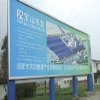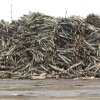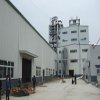Chinese puzzle reveals even more capacity
2 August 2010Readers may be astounded to see that world MDF capacity grew by 15.3 million m3 in 2009 compared with the 7.4 million m3 somewhat optimistically reported in last year’s survey.
Some readers may turn to the world capacity summary at the end of this articleto divine how this might have come about. There you will see fluctuations in the various regional capacities which typically occur year-on-year. However, there will undoubtedly be amazement to see the China capacity estimate, not at around 22.1 million m3 as expected, but rather showing an apparently explosive increase of 13.6 million m3 by the end of 2009. Explanations of these significant differences will be provided later.
According to our revised estimates for both 2008 and 2009, actual world capacity grew by just over four million m3, or 5.8%, in 2009.
Readers of Part 1 of the survey will have seen that in Europe and North America, aggregate capacity declined by about 240,000m3, or -1%. Combined capacity was 23,524,000m3 at the end of 2009, compared with 23,764,000m3 for 2008. In the rest of the world, (revised) capacity at the end of 2008 was 45,107,000m3 and reached 49,365,000m3 at the end of 2009.
The rest of the world possessed 67.7% of world MDF capacity and the ‘old MDF world’ just 32.3%.
When Parts 1 and 2 of the survey of 2008 were published last year, European and North American economies, and principal panel consumption drivers, were very much in the doldrums. The bright spots for MDF were in Asia and South America, Turkey and Russia. These regions supplied all of world capacity growth and the sharp decline in North American capacity offset the new developments during the year in Turkey and Russia.
Accordingly, the rest of the world region contributed all the growth reported in the global MDF sector and is the principal focus of Part 2.
This patchiness in MDF development and all the way up to national economies has, if anything, been exacerbated during 2009 and 2010.
The signs are very limited for improvements in the North American and European economies but China, with its vast domestic economy, is the engine for growth in Asia. Chinese furniture production in 2009 surpassed US$100bn (US$107 bn), whereas US housing starts ‘improved’ in 2010 to an annualised rate of one third of pre-2007 levels.
More than any other region, Europe is wrestling with the financial crisis. The need for public spending cuts and increased taxation is felt by many to herald a ‘double dip’ recession. The way forward seems to comprise many conflicting policies. Low interest rates for businesses (and government bor rowing!) are not helpful for savers and are harsh on all those in retirement relying on their investments.
Those made unemployed by corporate retrenchment and public sector budget cuts will find little solace – or opportunity for re-deployment – if retirement ages at the other end of the working population spectrum are extended.
The countries/regions where economic activity is more vibrant (and opportunities for MDF capacity development more dynamic), tend not to face these problems to the same extent and their regulatory climate is less financially burdensome and more conducive to economic progress.
China
Now we turn to China and the principal event of this year’s survey: the major uplift in the base level of Chinese MDF capacity. Last year’s survey predicted 22.1 million m3 of capacity at the end of 2009. This year’s survey shows 32.5 million m3!
It must be said that, if this new figure is to stand, then the estimate for end-2008 was 30.1 million m3. The growth in China was 2.4 million m3 during the year, which is quite close to the volume growth predicted in the 2009 survey (3.3 million m3).
Since the beginning of these capacity listings for bothMDF and particleboard, there has been an ongoing search for greater transparency in all markets, but in China in particular. For some years the author has been aware that learned Chinese spokesmen at both domestic and international events were reporting higher production and capacity totals than published in our survey. However, until such time as actual lists could be scrutinised to verify both the product definitions and the individual mill capacities, the author was in no position to offer any definitive and significant adjustments. Our original sources for China data were reliable industry sources, but a short time ago a new set of sources became available to us which, after translation, were shown to comprise association information, trade sources and media counts and clippings.
In summary, our survey showed 433 lines at the end of 2009 for 22.1 million m3 capacity, whereas the latest sources show 700 lines for 32.5 million m3.
Until the 267 additional lines can be identified, there is no other way to establish the reliability of the higher capacity figure. A significant part of the difference is the result of under-estimating the scope of installations by a number of domestic Chinese equipment manufacturers such as Shanghai Jiecheng Baihe; Dunhua Yalian, Sufoma or Dongwha. It has always been appreciated that most of these lines were small and that the capacity difference amounted to about 39,000m3 per annum per line.
The total shown for the Chinese listings is 32.5 million m3 but the 267 lines have not been shown this year. Space and time did not permit a full scrutiny of the lists to reconcile our original data with the new sources. The difficulties encountered included:
• the new names which needed to be compared with our original lists to confirmthat they were new;
• since before 2000, it has been a feature of many Chinese companies to rename and English translations are not always readily identifiable;
• name changes have been brought about by changes in ownership; mergers and acquisitions are quite a feature among the Chinese panel companies;
• there are errors within the sources themselves relating to capacity of lines and their production dates, as well as simple omissions.
We cannot pretend that these latest estimates are definitive and have reason to believe they are not. It is noted that numerous new lines from 2008-2010 are recorded at capacities lower than that achieved by the owners within a short space of time. Fifty percent improvements are not uncommon. This might suggest that at 32.5 million m3, Chinese capacity could still be understated!
Mill visits are a surer way to record capacity and production but even our intrepid and redoubtable editor, Mike Botting, cannot check out 263 mills all over China – and keep his present job!
Apart from the actual total installed, and projected capacity, how does the new data offset the view of the market from that described previously?
The major corporate groups are largely unchanged. The top 15 see only two changes, with Shanghai Green Continent dropping out and Dong Zheng being included.MianxianWood Based Panel Corporation has changed names to Zhongxin Forest Products Company. Another four lines have been added to Luyuan Group. A new line has been identified for China National Salt, as well as for Dongdun. The old PTP Company also has a name change to Leshan Jixiang and is becoming quite a significant group.
Please note that the listings still contain asterisks (*). These show lines planned or under construction. The total capacity shown for each company includes these lines but the grand total at the end of the list does not.
Comparisons between the sources also show that all the lines either operating or under construction, with foreign equipment, have been covered up until now. There are 60 foreign-made continuous press lines built or under construction, representing a total of 8.9 million m3.
Ostensibly, there are 43 domestic lines with continuous presses but 37 are calender presses. Virtually all of these derive from the Chinese manufacturer’s association with Binos of Germany. Six lines can be identified with continuous presses of domestic origin – five from Yalian and one from Shanghai Wood Based Panel Machinery Co Ltd (SWPM).
Not unexpectedly, the new sources show a number of small groups not previously recorded and operating with three to six average-size lines.
Further analysis of interest shows the location of new capacity. The active provinces in the past two years are:
Sichuan has added 13 lines since 2008 and Hebei 12, but Guangdong 16. From 2010, Sichuan – a major growth province – plans 12 lines (for 1.5 million m3). Hebei and Guangdong will also be active, with 12 lines between them.
The total number of lines delivered in 2008 and 2009 was 97, with 33 coming in 2009. 2008 saw the most lines delivered since 2004, when 76 were supplied.
The additional competition has given an impetus to exports, which languished in 2009 at just about 1.6 million m3 compared with 2.3 million m3 in 2007. 2010 to end- May shows a doubling over 2009 levels to exceed two million m3, at least.
Developments in other regions
Yet again South America was active. At least two of the SWPM lines sold into Brazil started production and we have shown the other two as start-ups in 2009 but cannot be sure. Floraplac and Duratex are opening lines – the latter being one of the largest in the world. The Eucatex plant expected in 2009 has been postponed until late 2010.
It is not confirmed, but we believe two new lines in India – Teekays and Greenply – are opening a total of 310,000m3 per annum of capacity between them.
Pakistan received a new small line and Kwang Won, Korea, completed its expansion.
Indeed most Korean lines have been modified in the past year or so, adding at least 180,000m3 to national capacity.
Without confirmation, we have recorded the new Vanachai line at Surathani for 300,000m3 per annum. Elsewhere, in Japan and Australia/New Zealand the situation has been very quiet. Their economies are weak and Japanese housing starts in 2009 were at their lowest level for 30 years.
Future Trends
To underline the strength in the rest of the world, there are about 71 lines under construction, which is bound to increase with slippage from previous years. China will account for 44 of these lines, allegedly in 2010, and a further 12 in 2011; in 2010 China Salt will start two lines for (at least) 420,000m3 per annum and Sichuan Guodong Construction has three lines for 660,000m3. There are at least four additional lines for a further 600,000m3. Total new capacity in China will be 4.64 million m3, moving the (new) total to over 37 million m3 by end-2010 and over 38 million by end-2011. Beyond 2011, only China Salt has informed WBPI’s editor of a plan for three further lines but no orders, we believe, have been placed as yet.
Elsewhere, Brazil will see the delayed Eucatex plant (250,000m3 per annum). The Advance Fibreboard extension in Thailand (200,000m3 per annum) will also come on stream in 2010. In Indonesia, PT Sumatera Prima Fibreboard (260,000m3) should also be in production in 2010.
In 2011, a further mill in Brazil is expected with the Berneck plant (414,000m3 per annum). The first line in Columbia is also expected – Tablemac (130,000m3 per annum). Segamat in Malaysia reports a 40,000m3 per annum expansion in the same year.
There are also announcements for 2012 from Fibraplac in Brazil (250,000m3 per annum). Fibraplac also has a longer term plan to add to this line, in 2014, a further 250,000m3 per annum.
Dongwha of Korea confirms a plant in Vietnam (300,000m3 per annum) for 2012 and not 2010 as reported last year. Of a more speculative nature are the possibilities of mills in India and perhaps the 500,000m3 per annum Eucatex plant in Brazil. Indonesia is another possibility for South East Asian, or even Japanese, investment.
The impact on global capacity of these changes is shown in the World Regional Summary table opposite.
By end-2011, world capacity will exceed 83 million m3, with 45.7% located in China.
MDF capacity in several Chinese provinces will exceed that of many major industrial countries in the world. South America will pass seven million m3 per annum in 2011 – one year later than forecast in 2009. South East Asia will also be a regional player, larger than North America.
Once again the editor and author thank profusely all those who contributed to the Survey. We hope by the next MDF Survey in 2011 to have digested the new Chinese information and to have found a succinct way to present it to our readers.



